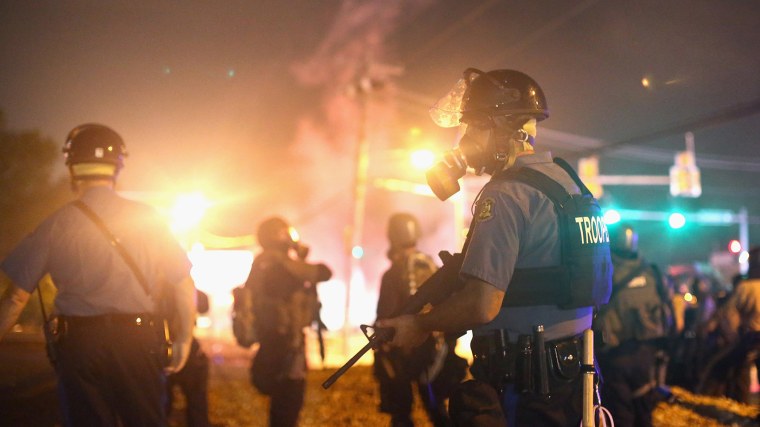On Friday morning, it was easy to feel a sense of optimism, if not relief, about developments in Ferguson, Missouri. State Highway Patrol officials had taken charge and
the shift in the prevailing winds was immediate.
As we consider the community's conditions 72 hours later, the respite was far too brief. The
msnbc report on last night's violence suggests the crisis is intensifying.
Multiple shootings, fire bombs and tear gas marked the worst night of violence in this St. Louis suburb that has been engulfed in tensions since a white police officer killed an unarmed black teenager on Aug. 9. [...] Hours later, after a midnight curfew was in place and the streets were largely quiet, Captain Ron Johnson told reporters that the aggressive response came after multiple shootings -- some aimed at police -- Molotov cocktails and looting had occurred in what he claimed was an orchestrated effort "designed to damage property, hurt people and provoke a response." Johnson, the Missouri Highway Patrol Captain, assigned by [Gov. Jay Nixon] to help restore calm in Ferguson, said at least two people were injuries in the shootings but that no police officers were hurt.
Johnson added this morning that Sunday began as a day of "peace and justice" ultimately "took a dark turn."
Missouri Gov. Jay Nixon (D) added that many of those involved in last night's incidents are "from outside the community and state," who are in turn "putting the residents and business of Ferguson at risk."
And with that in mind, the governor announced this morning that he has ordered the Missouri National Guard to assist in the response to the crisis. Nixon said the move is necessary due to "deliberate, coordinated and intensifying violent acts."
Complicating matters, we're now also learning more details about the Michael Brown's death.
The
New York Times reported overnight on an independent autopsy of Brown's remains.
Michael Brown, the unarmed black teenager who was killed by a police officer, sparking protests around the nation, was shot at least six times, including twice in the head, a preliminary private autopsy performed on Sunday found. One of the bullets entered the top of Mr. Brown's skull, suggesting his head was bent forward when it struck him and caused a fatal injury, according to Dr. Michael M. Baden, the former chief medical examiner for the City of New York, who flew to Missouri on Sunday at the family's request to conduct the separate autopsy. It was likely the last of bullets to hit him, he said.
There were some reports last week about Brown possibly having been shot from behind, but this latest report suggests all of the shots, including four to his right arm, were fired into his front. The Times' report added, "The bullets did not appear to have been shot from very close range because no gunpowder was present on his body. However, that determination could change if it turns out that there is gunshot residue on Mr. Brown's clothing, to which Dr. Baden did not have access."
The Justice Department intends to do an autopsy
of its own.
Update: In a bit of a
surprise, Gov. Nixon dispatched the National Guard to Ferguson late Sunday "without letting the White House know first."
